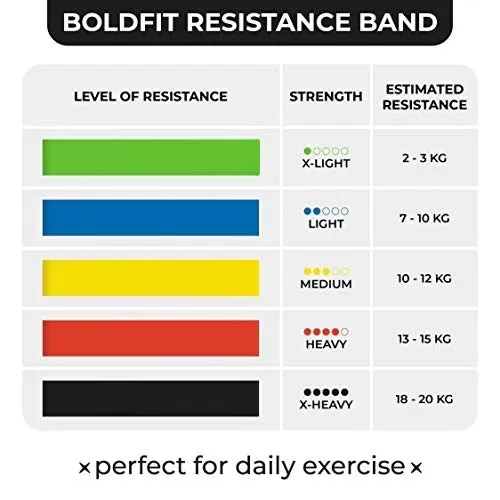Choosing the right resistance band in kilograms (kg) for beginners involves selecting a band that offers an appropriate resistance level for your current fitness and strength level. Here are steps to help you choose the right resistance band:
#1. Assess Your Fitness Level:
Before choosing a resistance band, it’s essential to assess your current fitness level. If you are new to resistance band training or have limited experience with strength exercises, you are considered a beginner.
#2. Understand Resistance Levels:
Resistance bands come in various levels of resistance, and they are typically labeled with a resistance range in kilograms. As a beginner, you should look for bands with a lower resistance level. Light resistance bands for beginners usually offer around 2-7 kg (4.4-15.4 lbs) of resistance.
#3. Check the Product Label or Description:
When shopping for resistance bands, carefully read the product label or description to determine the resistance level. Manufacturers often provide information about the resistance level in kg or lbs. Choose a band within the recommended range for beginners (e.g., 2-7 kg).

#4. Consider Your Exercise Goals:
Think about your specific exercise goals. If you’re primarily looking to improve your flexibility, and endurance, or perform bodyweight exercises, a light resistance band should be sufficient. If you aim to build strength, you might start with a light band for initial conditioning and then progress to a medium resistance band as you become more comfortable with the exercises.
#5. Try Different Bands (if possible):
If you have the opportunity, try out different resistance bands to get a feel for the level of resistance that suits your needs. Many fitness stores or gyms offer the option to test the bands before making a purchase.
#6. Seek Expert Guidance:
If you’re uncertain about which resistance band to choose, consider seeking guidance from a fitness professional or personal trainer. They can assess your fitness level and provide recommendations tailored to your specific goals.
#7. Gradually Progress:
As a beginner, it’s crucial to start with a resistance band that allows you to perform exercises with proper form. Once you become more comfortable and stronger, you can gradually progress to bands with higher resistance levels.
#8. Consult a Fitness Professional:
If you’re unsure about which resistance band to choose, consider consulting a fitness professional or a personal trainer. They can assess your fitness level and help you select the appropriate resistance level based on your goals.
#9. Safety and Progression:
- Safety should be a priority. It’s better to start with a lighter resistance band and gradually progress to heavier ones as you become more comfortable and stronger.
- Many exercises can be modified to increase or decrease the level of resistance. For instance, you can adjust the length of the band or double it up to increase tension.
Resistance band weight calculator
Variable Resistance Band Weight Calculator
Keep in mind that resistance bands are versatile and can be used for a wide range of exercises. Starting with the right level of resistance will help you avoid overexertion and ensure a safe and effective workout. As you gain experience and strength, you can gradually upgrade to bands with higher resistance to continue challenging yourself and achieving your fitness goals.

